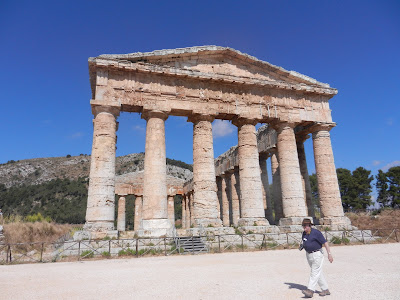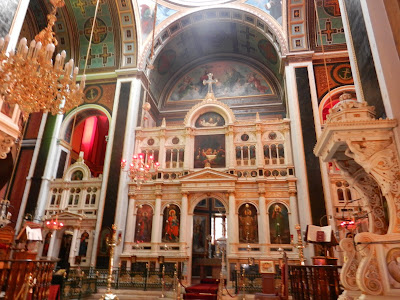Day 6 – Trapani, Sicily
Another lovely morning as our ship pulls into harbor at Trapani, on the northwest coast of Sicily. We quickly board the buses for the inland town of Segesta, where a splendid Greek temple, begun in 424 bc, stands sentinal.
A five-minute bus ride above the temple is a lovely amphitheater, dating from the same period, overlooking a pastoral landscape. Our guide, Smora, sings something (an anthem; an opera aria?) in Greek and we can all hear her beautifully. It clearly makes the point that the acoustics are stunning! There are many there besides our group and the applause was unanimous! How did they know about acoustics back then?
Lunch is off the boat at a charming spot along the beach.
We do a quick walking tour of downtown Trapani, then re-board the boat for a 4:15 departure toward Naples and Pompeii.
John remembers about today:
We notice that it starts with bigger rolls overnight and much of the early morning. For much of our trip the water has been very smooth. There are longer, deeper rolls in the sea. We're in rougher seas than we have seen before now. Anyway, it's rolley. We get back on schedule and it’s still rolley (9:50 pm between Trapani and Messina). We are in Italian waters; they drive on the right side of the road. As usual, we sail in the afternoon, arrive around breakfast.
Trapani is different because the land around it is so different. Enormous peaks, hardly mountains, but significant heights compared with where we’ve been before. The harbor, again, is great. There are two exits: one for commercial vessels such as ours, but another for smaller craft. Boats here are small boats, only one major yacht, some ferries. It is a working harbor. We dock on the side with the only working gangplank without issue. It’s still hanging out to the side, like a broken wing.
We arrive about breakfast. We board, then got off the bus. Because of a local antique car race, we know it will be unlikely to get to the mountain town. There are high ridges, somewhat like Tuscany, where we lived for a week in Montepulciano. Coaches are available, but the timing is tight. A delegation of nine people comes on board to clear us for disembarkation. There is a fair amount of diplomacy involved, but we are off the ship in good time.
We sit on the bus for 50 minutes inland, from Trapani to Segesta, a truly dramatic ruin in remarkable shape. All of its columns and all of its crossbars are in place after nearly 2500 years. The area is one that has earthquakes, but none has shaken these stones. Today it was spectacular against a crystal-blue sky that would have done San Francisco proud. The panorama is one of deep valleys and high mountains with dramatic clouds clinging to the tops. The temple is in a relatively low-level place; there were areas higher than it that were the sites of urban habitation. There is a spectacular amphitheater, a mile’s drive above the temple, what an incredible surprise! Built about the same time as the temple, it commands a wonderful view of a very deep valley with an expansive vista. Several of the members of our party climb up and down, but we take the bus out of concern that we’d miss the return bus.
On top of the site, there is extensive restoration taking place of another site. We have lunch off the boat. Our tour guide was clearly a gourmand, describing the meal we were likely to enjoy and, indeed, we did. A full meal that people would probably have eaten more, but most expected many more courses, so we quit and were a little surprised when the meal did, too.
There is a World War II gun placement and a stunning array of decaying wooden boats.
There is a World War II gun placement and a stunning array of decaying wooden boats.































